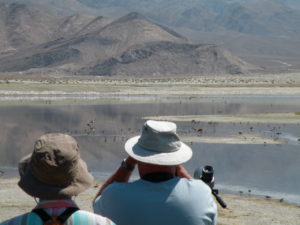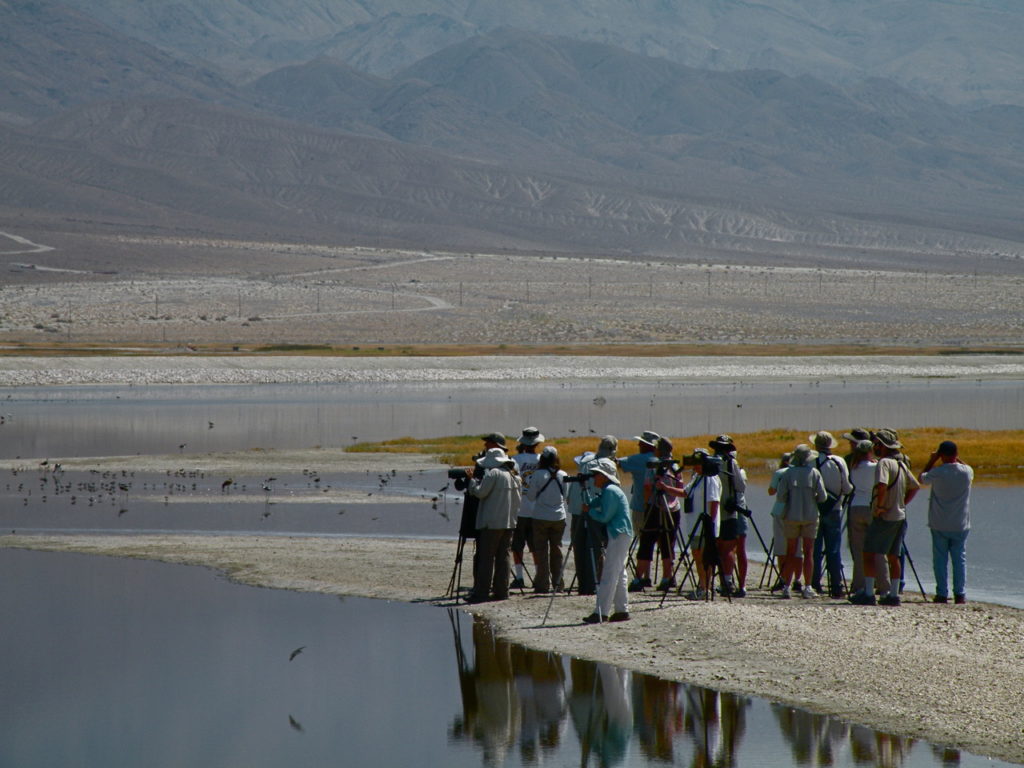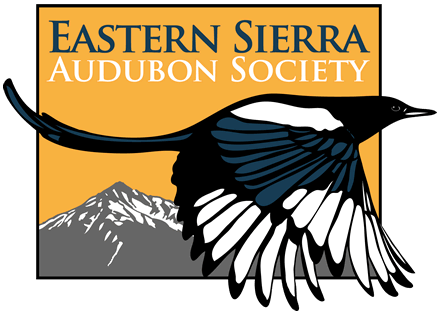Critical Audubon Importance At Owens Lake
Owens Lake is once again hosting hundreds of thousands of shorebirds migrating through the Eastern Sierra each spring and fall. These marathon migrants need fueling stopovers, sometimes a thousand miles or more apart, to replenish fat reserves for the next leg of their journey. Owens Lake has become the richest wildlife location in Inyo County.
 A resurrection, in a sense, has occurred at Owens Lake in that it existed for millennia, was later dried up to quench the thirst of a growing city and now has returned with the efforts to control dust. In 1913 when Los Angeles diverted the Owens River, the lifeblood of Owens Lake, the lake’s fate was sealed. Habitat of countless migrating birds was destroyed and the largest hazardous dust generator in the United States was created. Since 2001 Los Angeles has been compelled to control this dust hazard and has been using water as one of its tools. Once the water was released onto the lakebed primitive algal mats began appearing, brine flies descended on the algae in breeding and feeding frenzies and the table was set for the birds. The original simple food chain had been recreated from vestiges of life that had survived in small springs and wetlands after the lake had dried. This was a delight for the birders who saw it coming. To Los Angeles it was more of a awkward surprise.
A resurrection, in a sense, has occurred at Owens Lake in that it existed for millennia, was later dried up to quench the thirst of a growing city and now has returned with the efforts to control dust. In 1913 when Los Angeles diverted the Owens River, the lifeblood of Owens Lake, the lake’s fate was sealed. Habitat of countless migrating birds was destroyed and the largest hazardous dust generator in the United States was created. Since 2001 Los Angeles has been compelled to control this dust hazard and has been using water as one of its tools. Once the water was released onto the lakebed primitive algal mats began appearing, brine flies descended on the algae in breeding and feeding frenzies and the table was set for the birds. The original simple food chain had been recreated from vestiges of life that had survived in small springs and wetlands after the lake had dried. This was a delight for the birders who saw it coming. To Los Angeles it was more of a awkward surprise.
Thanks to Eastern Sierra Audubon birders (esaudubon.org), who collected bird data at the lake and knew it well for many years prior to the dust control project, the returning birds were given a voice. They were welcomed home.
Public Trust values requiring the balancing of wildlife populations with the water rights of Los Angeles were won at Mono Lake in the 1983 California Supreme Court case. The shadow of that decision fell across Owens Lake. Public Trust law guided and formed the Owens Lake Master Plan so that it became the ‘three legged stool’ – habitat protection/enhancement, water savings and dust control.
 The role of Audubon in helping make this historic accomplishment possible was profound. It played a critical role by organizing a field trip in 2006 that sought to create a comprehensive management plan for Owens Lake. Virtually every stakeholder participated and warmed to the broader management concept. This model of a comprehensive plan was eventually recognized as a viable path by Los Angeles and collaborative work began on the Owens Lake Management Plan. The compromise of saving water and supporting habitat was made between Audubon and Los Angeles Department of Water and Power. This was the grand bargain. Audubon also brought expertise and professionalism with its advocacy. Its voice was one of calm reason and at times helped keep all of the parties ‘in the room’ when discussions broke down and the conversation became strained.
The role of Audubon in helping make this historic accomplishment possible was profound. It played a critical role by organizing a field trip in 2006 that sought to create a comprehensive management plan for Owens Lake. Virtually every stakeholder participated and warmed to the broader management concept. This model of a comprehensive plan was eventually recognized as a viable path by Los Angeles and collaborative work began on the Owens Lake Management Plan. The compromise of saving water and supporting habitat was made between Audubon and Los Angeles Department of Water and Power. This was the grand bargain. Audubon also brought expertise and professionalism with its advocacy. Its voice was one of calm reason and at times helped keep all of the parties ‘in the room’ when discussions broke down and the conversation became strained.
Today, through the efforts of Eastern Sierra Audubon, Owens Lake is an Audubon Important Bird Area (www.ca.audubon.org ) and is being nominated to become a part of the Western Hemisphere Shorebird Reserve Network (www.whsrn.org).

Each spring and fall since 2008 Eastern Sierra Audubon partners with the Los Angeles Department of Water and Power to conduct the Spring and Fall Owens Lake Big Days when the entire lake is surveyed for birds. In addition to that, on the last weekend in April Friends of the Inyo (www.friendsoftheinyo.org), Eastern Sierra Audubon and others partner to host the Owens Lake Bird Festival in Lone Pine.
Although the success at Owens Lake was a group effort by many Auduboners, three individuals stood out as leaders and tireless champions. Eastern Sierra Audubon’s Mike Prather started it all in the early 1980’s. with his Owens Lake birding and the organizing of a voice for the birds. He soon partnered with Eastern Sierra Audubon’s Pete Pumphrey whose leadership and vision linked Eastern Sierra Audubon with Audubon-California and the other major stakeholders. Lastly, was Andrea Jones, Audubon-California’s Director of Bird Conservation, who brought National Audubon gravitas at the highest level that was so valuable when working with the Los Angeles Department of Water of Power, the California Department of Fish and Wildlife and the California State Lands Commission. These were the ‘Three Amigos’.
Online video:
- The Legacy of Owens Lake (YouTube)
- Owens Lake Bird Festival – 2015 (YouTube)
- Just Fix It: Showing Up YouTube
Other web links:

